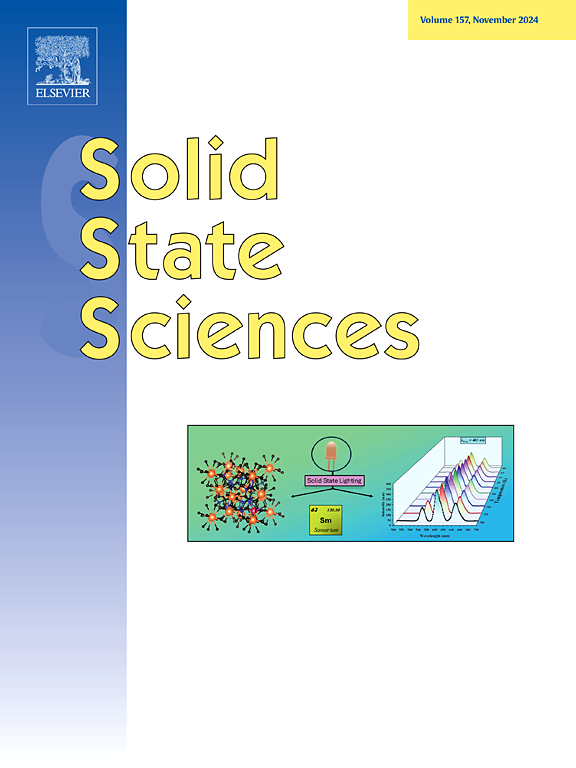新型层状四元锌镍氧化物Ba2Zn2Pn2O (Pn = Sb, Bi):发现、晶体结构、能带工程和输运性质
IF 3.3
3区 化学
Q2 CHEMISTRY, INORGANIC & NUCLEAR
引用次数: 0
摘要
合成了Ba2Zn2Sb2O、Ba2Zn2Bi2O和固溶体Ba2Zn2Sb2−xBixO (x≈1.1 ~ 1.6)三个新的异阴离子氧醛酸盐,并对其结构进行了表征。它们与含锰类似物呈等结构,采用ba2mn2sb20型结构(空间群P63/mmc, No. 194),具有双层2D 2∞[Zn2Pn2O]2-子结构(Pn = Sb, Bi, Sb/Bi),由共享角的畸变四面体znpn30单元组成。电子结构计算表明,随着铋含量的增加,从半导体Ba2Zn2Sb2O到金属Ba2Zn2Bi2O的系统进展。这些趋势得到了输运性质测量的证实,在300-600 K温度范围内,Ba2Zn2Sb0.9(1) bi1.10表现出相对较低的电阻率,约160 cm2/V·s的高霍尔迁移率和69至132 μV K−1的大塞贝克系数。与结构相关的锌nicl化合物,如SrIn2As2和PrZn3As3相相比,Ba2Zn2Pn2O (Pn = Sb, Bi)属于更广泛的异阴离子氧nictide Zintl化合物家族,突出了它们的结构灵活性和能带工程的亲和性。电子结构和键合的考虑指向可调谐的半导体行为,并强调了这些材料在热电和拓扑应用中的相关性。本文章由计算机程序翻译,如有差异,请以英文原文为准。

New layered quaternary Zintl pnictide oxides Ba2Zn2Pn2O (Pn = Sb, Bi): Discovery, crystal structures, band engineering, and transport properties
Three new heteroanionic oxypnictides, Ba2Zn2Sb2O, Ba2Zn2Bi2O, and the solid solution Ba2Zn2Sb2−xBixO (x ≈ 1.1–1.6), have been synthesized and structurally characterized. They are isostructural with their Mn-bearing analog, adopting the Ba2Mn2Sb2O-type structure (space group P63/mmc, No. 194), and feature a double-layered 2D [Zn2Pn2O]2- substructure (Pn = Sb, Bi, Sb/Bi) composed of corner-sharing, distorted tetrahedral ZnPn3O units. Electronic structure calculations reveal a systematic progression from semiconducting Ba2Zn2Sb2O to metallic Ba2Zn2Bi2O as Bi content increases. These trends are corroborated by transport property measurements, with Ba2Zn2Sb0.9(1)Bi1.1O exhibiting relatively low electrical resistivity, high Hall mobilities of ∼160 cm2/V·s, and large Seebeck coefficients from 69 to 132 μV K−1 over the 300–600 K temperature range. Comparison with structurally related Zintl pnictides, such as SrIn2As2 and PrZn3As3 phases, situates Ba2Zn2Pn2O (Pn = Sb, Bi) within a broader family of heteroanionic oxypnictide Zintl compounds, highlighting their structural flexibility and amenability to band engineering. Electronic structure and bonding considerations point to tunable semiconducting behavior and underscore the relevance of these materials for thermoelectric and topological applications.
求助全文
通过发布文献求助,成功后即可免费获取论文全文。
去求助
来源期刊

Solid State Sciences
化学-无机化学与核化学
CiteScore
6.60
自引率
2.90%
发文量
214
审稿时长
27 days
期刊介绍:
Solid State Sciences is the journal for researchers from the broad solid state chemistry and physics community. It publishes key articles on all aspects of solid state synthesis, structure-property relationships, theory and functionalities, in relation with experiments.
Key topics for stand-alone papers and special issues:
-Novel ways of synthesis, inorganic functional materials, including porous and glassy materials, hybrid organic-inorganic compounds and nanomaterials
-Physical properties, emphasizing but not limited to the electrical, magnetical and optical features
-Materials related to information technology and energy and environmental sciences.
The journal publishes feature articles from experts in the field upon invitation.
Solid State Sciences - your gateway to energy-related materials.
 求助内容:
求助内容: 应助结果提醒方式:
应助结果提醒方式:


